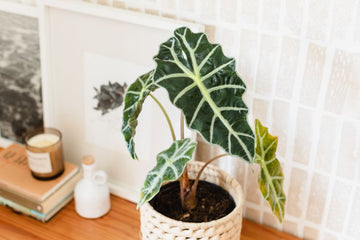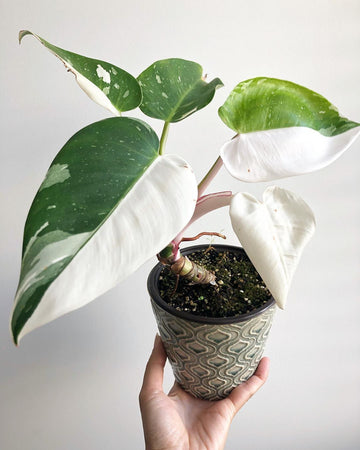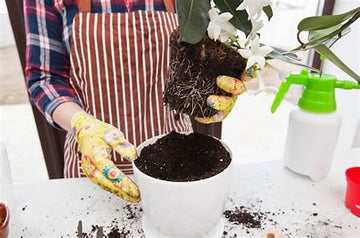If you're seeking a genus of plants that boasts some of the most stunning, eye-catching, and unique foliage to showcase in your home, look no further than the Alocasia genus. Commonly known as Elephant Ears, these captivating tropical plants are native to the South Pacific Islands, particularly the Philippines, as well as parts of Asia and Eastern Australia. Thriving in their natural habitat, they flourish in moisture-rich, humid environments, typically found on the forest floor beneath the dense canopy of towering trees. This environment has shaped them to develop large, dramatic leaves, enabling them to outshine other jungle plants in the race for precious light. Some Alocasia varieties can even produce leaves that stretch up to 3 feet in length!

Light Requirements
Just like in their natural environment, where the broad leaves reach for the dappled sunlight from the forest floor, Alocasias love bright, indirect light. Their large leaves allow for plenty of surface area to absorb the bright light that they love and they will produce larger and larger leaves when they receive these light levels. They should be placed in a location where they can "see" as much of the sky as possible, some morning or late afternoon sun will be just fine as well, and they will stay as compact as possible, pushing out plenty of new growth.
The lowest light conditions that Alocasias can handle, which would be in the medium light classification of the indoor lighting spectrum, include the following:
- In the middle of a room with a regular-sized South, West, or East facing window
- Next to a North-facing window
- Next to a South, West, or East facing window that has obstructions (i.e. nearby condo, overhang, large tree, etc.)
When in their lowest light settings, houseplants will more often retain the shape that they come in or become stretched. The rate of growth will also be slower, the size of the new leaves will probably be on the smaller side, and there may even be some leaf loss, as plants will shed what they can't support. Remember that plants will grow based on how much light they receive, so this is something to keep in mind when you are choosing where to put your plant!
Watering Requirements
Since they grow in the tropics in their native environment, Alocasias enjoy humid, moist conditions, but not overly soggy soil. They store some water in their thick stems, as well as their rizhomes, or tubers, so they can be slightly tolerant of drier soil. Letting the soil go a little dry is important for two reasons: 1) they are sensitive to overwatering and 2) we want to let oxygen get to the roots. Water your plant when the top half of the soil is dry to the touch, which can be checked by sticking your fingers into the soil to feel for the moisture levels, if your finger comes up dry - it is time to water. Water the potting mix thoroughly, until it is evenly moist, allowing any excess water to drain out and dump this excess.
🚨Avoid letting your plant get extremely wilted, this can cause brown tips on your plant, as well as resulting in some leaf loss. Also, letting your plant go from extremely dry to extremely soaked very often can stress a plant out, which can lead to browning on leaves and leaf loss as well. Although they will tolerate slightly drier soil, you never want to let it go too far. Keep the soil of your plant evenly moist, not soggy but not bone dry.
As for the frequency of watering, or how often to water, that will all depend on the light your plant is receiving, the warmth and humidity of your home, the size of the pot, as well as the pot that the plant is planted in. Generally, no two plants will be on the exact same watering frequency, as everyone's home is different! That being said, try to stay on a consistent watering schedule. You should expect to water your plant more often in the spring/summer months though, when the days are longer, warmer, and brighter, and less often in the dormant winter months when the days are shorter, cooler, and darker.
Humidity
They key to Alocasias is high humidity. As we mentioned above, they love moisture but not soggy soil, so the humidity around the plant is key to increase those moisture levels. Even though some varieties can handle lower humidity, the wear and tear of the dry air will begin to show on their leaves, through crispy tips or yellow edges. Be sure to keep them away from any drafts, such as cold windows in the winter, cold rooms, radiators, or any heating/air conditioning vents blowing air though. They are still a tropical plant so they won't do well being placed in a cool, dry area in the long run!
🌫
If you truly want to spoil your plant, keep it in an enclosed greenhouse with a humidifier and some air circulation, providing that warm, moist, and humid environment. Your plant will love you that more!
Even though they can survive in our basic home humidity, they love a warm, humid environment. If you are willing to spend the extra time and effort, here are some ways you can increase the humidity in the air around your plant:
- Mist your plant's leaves every day to increase the ambient humidity for a short period of time around the plant
- Group your plants together with similar moisture needs, this will also increase the ambient humidity around your plant
- Place the nursery pot on top of a bed of rocks that are covered in water (this increases the humidity in the air around the plant)
- Invest in a humidifier to increase the overall humidity in the room (this will benefit any other plants you have as well)
It is important to keep your plant in a warm room, with temperatures between 18 - 30 C, as well as with increased humidity, since cooler temperatures could force your plant into dormancy. Fluctuations in temperature can also inhibit growth, as well as potentially damaging the sensitive leaves of Alocasias. Even though they are grown as houseplants, keeping your plant outdoors during the Spring and Summer months can be incredibly beneficial to it, since the natural warmth and humidity will create a beautiful environment for it (avoiding the AC).
Dormancy
Even though most houseplants tend to go through a period of dormancy during the Fall and Winter months, we wanted to include a specific section for Alocasia's as they certainly will go through this dormant period. Dormant periods can be shock to plant parents as there are things that occur, which never occurred normally, and that can be a little nerve-wracking! During an Alocasia's dormancy, their growth will slow down, or halting altogether, not producing any new leaves until the Spring months. They are even prone to leaf loss, potentially dropping all their leaves, if their conditions are not met throughout this time.
❄️
This is a part of the natural lifecycle of these plants as there is a lot less light during the shorter, cloudier days of the Winter months. As long as the leaves aren't yellowing because of pest damage, lighting issues, or watering inconsistencies, don't fret! Get excited for the new life that is sure to come when the days begin to warm up again.
There is a lot less light during the shorter, cloudier days of the Winter months and this is all part of the plants natural lifecycle. Since they are not actively growing, it is best to water less often (not with less water each time) than you had been previously, waiting until the soil is mostly dry before doing so again. Also, hold off on fertilizing throughout this entire time period, as they don't need the food if they are not actively putting in energy to produce new leaves. Keep your plant in a bright, warm room, but away from and heaters or radiators, as they still will require that high humidity that they have become accustomed to, especially during those drier months.

Alocasia Dark Star
Finally, once the sun starts to show its face for longer periods during the Spring and Summer months, your plant should perk right back up and begin to grow as if nothing had happened. Don't worry if your plant is a little slower to start up again, they need a little bit of time to adjust, but then they should grow back as healthy as ever!
Fertilizing
Since Alocasias are known for growing quite quickly, if in bright light, it is essential that they receive the nutrients needed to support this growth. To fertilize your Alocasia, feed your plant once a month with a diluted liquid fertilizer for indoor plants, organic fertilizers are also a great option. If you wish to feed more often, make sure that the fertilizer is even more diluted. Too much plant food can result in the salts from the fertilizer building up in the soil and causing burns on the leaves. Also, hold off on fertilizing your plant throughout the wintertime, as they are in their dormancy period, described above, and won't need the additional nutrients.
🌸
It is possible for Alocasia to produce blooms, which are called inflorescences, with the typical spathe and spadix of all aroids, but they are quite unremarkable, especially compared to their eye-catching foliage.
Toxicity
Like all other aroids, Alocasia are toxic to both humans and pets. Due to the calcium oxalate crystals that all parts of the plant contain, they are best kept away from children and animals. If ingested, depending on how much, they can cause eye irritation, mouth irritation, tongue swelling/irritation, swelling of the throat, pawing at the face, and possible vomiting. Very rarely, extreme swelling of the upper airway can occur making it difficult to breathe.
The juices from the plant can also irritate your skin, leading to a rash if you are very sensitive, so make sure to use gloves when working with them or wash your hands after handling them. Keep the plant away from children and pets and call poison control, your doctor, or veterinarian if a person or animal ingests a plant leaf.
Common Pests & Problems
Alocasias can be quite finicky, especially when grown indoors in our dry, Canadian homes, but they can be kept happy if the above care steps are followed (focus on the humidity!). Despite happy conditions, there are still a list of potential problems they can experience throughout their lifespan. Here are the most common issues you could experience in your time with your Alocasias:
Brown edges or spots:
This could be due to the following reasons:
- Chemical burn - They are very sensitive to the build-up of salt in the soil, which can be from fertilizers or tap water, so ease up on how much you fertilize your plant or adjust the water you use, based on our watering guidelines above.
- Scorched foliage - Be careful not to keep your plant in the direct sun, as this can burn the foliage!
- Low humidity - Remember, they love humidity, so increase the humidity around your plant as we describe above.
- Fungal disease - While beautiful, they can be sensitive to a variety of diseases, such as crown, stem, or root rot, leaf spot, or Xanthomonas infection. These are mainly linked to watering issues to try to let the soil dry out more in between waterings, or repot your plant into fresh soil if the roots have rotted excessively.
Yellow leaves:
Although some leaf loss can be natural as leaves age, this can be due to the following:
- Overwatering - If your plant has been watered too often, Alocasia leaves can start to yellow, so be aware of this. Check if your plant should be repotted into fresh soil, then water as we explain above.
- Stress - Alternating between extremely dry soil to soaking wet soil can stress your plant out, try to remain on a consistent watering schedule, not letting the soil stay incredibly dry for too long, they are not totally drought tolerant.
- Low humidity - Low humidity and dry soil cause leaves to droop and brown on their edges, later followed by entire yellowing, browning, and shrivelling. Your Alocasia will appreciate a boost in humidity.
- Improper light - As Alocasias adapt to medium light levels, they could shed the leaves that they cannot support. Place your plant in brighter light if this is the case.
Limp, drooping leaves:
Droopy leaves are often caused by over or under watering, pests, insufficient light, insufficient humidity, or insufficient nutrients in the soil. Compare your care routine to the guidelines above and see if anything should be adjusted to get your plant back to its healthy state. Sometimes, leaves can become top heavy naturally, so if there are not other reasons, you could consider staking up the leaves.
Pests:
These beauties are prone to spider mites and thrips, as any pest will happily take up residence on a plant if given the opportunity. A thorough wipe-down of leaves and stems with soapy water or insecticidal soap can be effective at stopping them, though repeated applications will be necessary. You can see all of our guides to getting rid of pests here. A weakened or stressed Alocasia is more susceptible to insect infestations so make sure to keep it happy with its care routine!
Over-watering:
Alocasias are prone to root rot if their soil is kept too moist, so make sure to not water too often! Yellow, soft leaves can be a sign of this and they will most likely be shed if it goes too far. Keep an eye on your watering and water as we describe above.
Leaf loss:
This is often due to dormancy, as we mentioned previously. Unlike most other houseplants, they are sometimes able to bounce back after this leaf loss due to the reserve energy they store in their thick tubers. If this has happened to your plant throughout the Winter months, wait until the Spring, when nighttime temperatures stay above 10 C consistently, and place your plant outside in a bright, shaded location.
These amazing tropicals are an incredible plant to have in your home, with truly unique foliage and a commanding display. Despite their tendency to be a little finicky, they can live truly happy in the home as long as a few modifications are made. You definitely need one of each variety!





